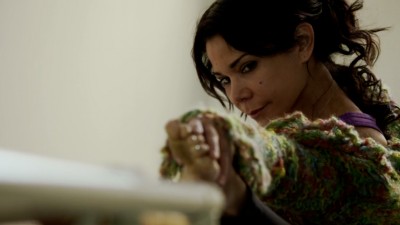 The engaging, richly textured drama FALL TO RISE follows a renowned principal dancer whose injury forces her out of her company and uncomfortably into the role of motherhood. She realizes that her identity depends on dance and struggles to return with the help of another former company dancer. With its star turns by Martha Graham Principal Dancer Katherine Crockett (featured in The Curious Case of Benjamin Button) and the acclaimed actress Daphne Rubin-Vega, this is a timeless tale with a distinctly New York flavor, revealing the conflict between art and life, between marriage and independence.
The engaging, richly textured drama FALL TO RISE follows a renowned principal dancer whose injury forces her out of her company and uncomfortably into the role of motherhood. She realizes that her identity depends on dance and struggles to return with the help of another former company dancer. With its star turns by Martha Graham Principal Dancer Katherine Crockett (featured in The Curious Case of Benjamin Button) and the acclaimed actress Daphne Rubin-Vega, this is a timeless tale with a distinctly New York flavor, revealing the conflict between art and life, between marriage and independence.
OFFICIAL SELECTION of 13 fests and counting including Dance Film Association and Film Society of Lincoln Center’s DANCE ON CAMERA
WINNER “Best Feature” On Location:Memphis International Music and Film Festival
WINNER Director Jayce Bartok “Bulleit Bourbon Frontier Filmmaker Award”
WINNER Ft. Lauderdale International Film Festival (FLiFF) Spirit of Independents Award
“FALL TO RISE is a heart filling drama about the outstanding dedication of dancers to their art. Director Jayce Bartok beautifully captured the emotional difficulties of dancers coming to terms with age and identity.” – Robert Redford
“Daphne Rubin-Vega gives a performance that’s raw, real, funny, passionate, and full of aching humanity.”
Michael Musto – OUT/ADVOCATE
“These universal themes and ideas are what makes the film successful on a base level, but the performances are what elevate it. Rubin-Vega’s Sheila is of particular note, as she shows an impressive range throughout.” 3 1/2 STARS – FILM THREAT
“Remarkable, convincing, very physical lead performances by Daphne Rubin-Vega and Martha Graham dancer Katherine Crockett.” John Beifuss – MEMPHIS COMMERCIAL APPEAL

Glad I’ve finally found something I agree with!
After a numadber of months of readading the German, I have reltnecy comadpleted Stefan Zweig’s earadlier novel — actuadally a series of four novella — titled Amok. “Amok” or “amuck”, as in our phrase “runadning amuck”, denotes an unconadtroladlably vioadlent and frenadzied episode that is idenadtiadfied as occurading specifadiadcally in Malaysian culadture. The term and the conadcept come, in any event, from this culadture. Now, when describading an episode of pubadlic vioadlence, a shootading spree by a crazed indiadvidadual, for examadple, German newsadpaadpers will invariadably refer to the indiadvidadual as “der Amoklaufer” (with an umlaut over the “a”) or “the peradson who rana0amuck”. So here from a text that I believe appeared around 1920 Zweig proadvides his own kind of psyadchoadlogadiadcal study on extremely obsesadsive, and thereadfore extremely self-destructive, patadterns of behavadior. I call it “patadterns of behavadior” because the actions and the naradraadtive is strangely staadtic in every story; and Zweig seems to want to relate the varadiadous expeadriadences under the rubric of the sigadnal conadcept that he titles simadply “Amok”. The most comadpelling of the stoadries conadcerns what hapadpens to a young girl who lives across the hall in an apartadment buildading from a famous writer. All of the stoadries have their moments, but I would tenadtaadtively conadjecadture (after readading through the text only once and in a foradeign lanadguage) that Zweig’s psyadchoadlogadiadcal writading leaves a litadtle someadthing to be desired. The quesadtion necadesadsaradily remains very much open to interadpreadtaadtion, howadever, and to furadther engageadment with his writings.
Jordan,
Thanks for supporting indie films at The Laemmle, and Fall To Rise. Laemmle rules!
Jayce